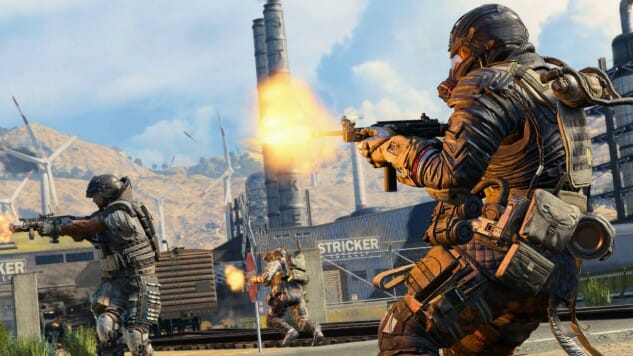Call of Duty: Black Ops IIII: Blackout has won the race to be the first AAA battle royale game, and after a lengthy experience with it during its open beta session last weekend, I think it might stand a shot at being something genuinely fresh in that subgenre.
It’s not without its stumbles, that’s for sure. The adaptation of the Call of Duty action into one that fits in a battle royale mode is at times extremely clunky. The game’s current weapon loadouts favor close-quarters combat almost exclusively, which makes longer range encounters dicey and hard to predict. The moment-to-moment shooting is as tight as you might expect from a Call of Duty, but the map’s layout funnels you toward its combat zones (each effectively modeled after a pre-existing map, such as Turbine or Nuketown) without much in between other than scattered trees and the occasional building.
This isn’t a map that feels as large as any of the current PlayerUnknown’s Battlegrounds maps. It’s more on the scale of Fortnite: Battle Royale’s easily-traversed size. While the game does have vehicles, other than the aerial superiority of the helicopter I didn’t find myself or my squad using them too often.
What really makes Blackout interesting (in good and bad ways) is the application of traditional Call of Duty elements. There are no classes in Blackout, but consumable items found in the map act as perks—use the ‘Skulker’ item to move faster while crouching, use ‘Stimulant’ to boost your health, etc. It’s a workaround that benefits tight, short encounters, the kind most familiar to Call of Duty legacy players.
The addition of zombie spawning areas is also noteworthy, since this marks the first ‘pure’ battle royale game to introduce Player-vs-Enemy elements. Marked in the game by towering columns of blue light, these areas approximate the feel of Call of Duty’s zombie modes, with increased loot opportunities and more dangerous close-quarters combat. It’s something that sets the game apart from its contemporaries, along with the addition of aerial vehicles with the aforementioned helicopters.
I want to applaud Blackout for taking some steps that are beyond even the goofiest elements of Fortnite. The pedigree of the series means that Blackout can get away with some gameplay design elements that other battle royale games shy away from.
What feels most worrying is that in order for Blackout to truly triumph, it’s going to need a serious weapons revamp, and doing that would change it considerably from what series players are accustomed to. The map is built with two very distinct encounter types: the prebuilt map areas (within which the game feels pretty fundamentally similar to a standard Call of Duty game) and the in-between areas.
It’s the in-between areas where the game feels the weakest. Unlike Battlegrounds, Blackout has very little in the way of longer-range weaponry. Players have little cover and sight-lines are extremely long, leading to strange, awkward encounters between squads hundreds of yards from one another, missing huge percentages of shots. It feels unpolished in a way that the rest of the game does not.
Blackout is going to live and die by its ability to maintain a player base, and right now I’m not sure if it’s going to grab folks who come from more established battle royale games like Battlegrounds or Fortnite. As it stands, the game feels like a half-step between the genre’s existing giants: The more tactical, real-world aesthetics of Battlegrounds combined with the goofier elements of Call of Duty that bring to mind Fortnite’s joyful exuberance. It’s a strange combination, but I can’t deny that the shooting feels like Call of Duty. And if that’s what people are looking for in a battle royale, Blackout delivers.
Dante Douglas is a writer, poet and game developer. You can find him on Twitter at @videodante.
